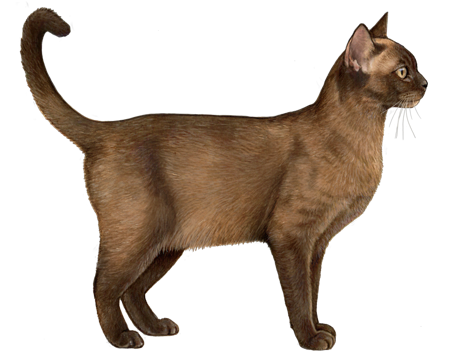
Khaomanee
Khaomanee cats are intelligent, social, and known for entertaining their humans with silly antics. According to people in their native Thailand, they also bring good luck to those who share their home. What more could you ask for from a loyal companion?
Interested in discovering if your cat is a Khaomanee?
Check out Wisdom Panel's DNA test.
Khaomanee Traits
General Appearance
The Khaomanee is a medium-sized breed built for Thailand's warm climate. These cats have lithe bodies, medium-length noses (that handle hot air better than short noses), and short white coats.
Coat and Coloring
Khaomanee cats come primarily in pure white. Other colors are possible, but they're not allowed under the breed standard. Their eyes are shades of blue, gold, green, or odd-eyed (two different colors). And their fine, medium-short coat is smooth enough to see muscles beneath the hair and has a somewhat sparse undercoat.
Distinctive Physical Traits
Other prominent features of the Khaomanee include a heart-shaped head, high cheekbones, large, upright ears, and a medium-length, tapering tail.
Khaomanee Temperament
Khaomanee cats are known for their playful, mischievous personalities. They're very people-oriented and take it upon themselves to greet all visitors that come to the house. They also make devoted family members and willing playmates for kids.
These curious, intelligent cats like to explore their surroundings and excel at games of fetch. They tend to be vocal and aren't shy about letting their humans know what they're thinking. But they also know how to relax and enjoy taking breaks on a nearby couch or—better yet—a lap.
Khaomanee History
The Khaomanee is one of several breeds that originated in ancient Thailand. Early references to the breed—whose name translates to "white gem"—exist in The Cat Book of Poems written in the 14th century.
While other Thai cat breeds (e.g., Siamese, Burmese, Korat) gained global notoriety, the Khaomanee lived in relative obscurity to the outside world. But interest in the breed began to grow starting in 1999—when Colleen Freymouth imported a pair of Khaomanee to the United States and bred the first North American litter.
Today, this rare breed is working toward full recognition with both the Cat Fanciers Association and The International Cat Association.
Khaomanee Care
Nutrition
Khaomanee require a high-quality diet. Because nutritional needs vary for kittens, adults, and senior cats, opt for a formula that's age-appropriate for your pet.
To keep your cat at a healthy weight, measure out meals and reduce portions if necessary. And don't forget to account for treats. As a guideline, they should make up no more than 10% of a cat's calories.
Finally, all cats need access to fresh, clean water around the clock.
Grooming
The Khaomanee's short coat is relatively low maintenance. Weekly brushing to remove dirt and loose fur will keep it shining white.
Most cats' nails require monthly trimming to prevent them from getting too long. Long nails are more likely to snag on something and become torn or damaged. They can even grow into your cat's paw pads, leading to pain or infection. In addition to clipping, providing a scratching post will allow your cat to do some nail maintenance themselves (thanks to their instinct to scratch).
No grooming routine is complete without a little dental hygiene. To support your Khaomanee's overall health, brush their teeth daily and schedule visits with your veterinarian for professional dental cleanings and exams.
Health
Roughly one out of every three cats in the United States is overweight or obese. And those extra pounds can contribute to other health risks—such as arthritis, diabetes, and heart problems. Your veterinarian is the best resource for tips on managing your cat's weight.
Breed Group
Asian
The Asian Group is comprised mainly of genetically similar breeds which vary widely in traits and personalities. These breeds are distinct from those of the Siamese and Oriental Group.
Resources
https://tica.org/breeds/browse-all-breeds?view=article&id=846:khaomanee-breed&catid=79
https://www.royalcanin.com/us/cats/breeds/breed-library/khao-manee
https://cfa.org/wp-content/uploads/2019/06/khao-manee-standard.pdf
https://www.banfield.com/state-of-pet-health/obesity
Reviewed February 23, 2021 by Annette Louviere, DVM
























